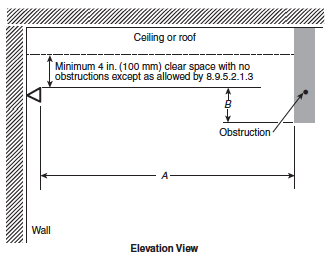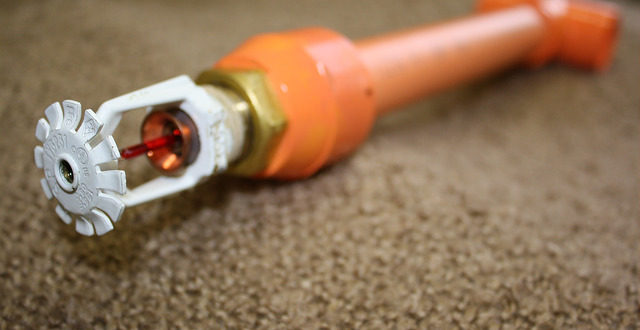Can They be Near the Sprinkler?
When using sidewall sprinklers can there be obstructions at the ceiling within 4 ft of standard sprinklers or 8 ft for extended coverage and residential sprinklers? Since the 2002 edition of NFPA 13, Standard for the Installation of Sprinkler Systems, it has been fairly well understood that obstructions were not allowed in this zone. This all changed with the 2016 edition.
Before delving into this latest change, let’s first look at a little history. Starting with the 1991 edition, section 4-4.2.4 stated:
“Sidewall sprinklers shall be installed where no beams or similar obstructions are located closer than 4 ft (1.2 m) from the sprinkler. Beams or similar obstructions located greater than 4 ft (1.2 m) from the sprinkler shall be in conformity with Table 4-4.2.4.”
On the other hand, Table 4-4.2.4 identified that obstructions could be less than 4 ft from the sprinkler as long as the bottom of the obstruction was at or above the plane of the deflector. The appropriate interpretation is that obstructions could be closer than 4 ft, but could be no closer than 4 ft when they extended below the plane of the deflector. The 1996 edition changed the format, fixing the little problem of implying a sidewall sprinkler could be installed perpendicular to beamed construction by saying light fixtures and similar obstructions. They also added text to address extended coverage sidewall sprinklers except that the minimum distance was 8 ft. The new text read:
“Sidewall sprinklers shall be installed no closer than 8 ft (2.3 m) to light fixtures or similar obstructions. The distance between light fixtures or similar obstructions located more than 8 ft (2.3 m) from the sprinkler shall be in conformity with Table 4-9.5.1.2 and Figure 4-9.5.1.2.”
The problem at that time was that Table 4-9.5.1.2 for extended coverage sidewall sprinklers did not have a similar allowance for obstructions closer to the sprinkler. This prompted the submittal of a proposal for the 2002 edition whereby Table 8.9.5.1.3 (the section number changed in 1999 and again 2002) would have an allowance to have obstructions closer to the sprinkler (as allowed for standard spray). This was approved in principle. There was also a comment from the technical correlating committee (TCC) directing that the two sections be reviewed to ensure that they were consistent. This comment was accepted with the following changes to NFPA 13:
A – deleted the first sentence of text from both section 8.7.5.1.3 and 8.9.5.1.3.
B – changed Table 8.7.5.1.3 from 0 in. to not allowed (for less than 4 ft).
C – added new line to Table 8.9.5.1.3 for less than 8 ft as not allowed.
This change emphasized that for extended coverage sprinklers obstructions could not be closer than 8 ft. It also changed the requirement for standard spray sprinklers no longer allowing obstructions within 4 ft. Since it was classified as an acceptance of a comment, no substantiation for the change was required or provided. A typical comment would have substantiation by the submitter which is accepted as being relatively accurate unless the committee states otherwise. The comment from the TCC had no substantiation since it did not propose a change but was just ensuring consistency within the document. As such, we have no documentation on the basis for this change. I do remember there being significant concern regarding the spray pattern of the extended coverage sprinkler but not for standard spray. Instead of justifying a difference, standard spray sprinklers were restricted so they would both be consistent. The same text from extended coverage sprinklers was also added to residential sprinklers in the 2002 edition.
Things stayed static for 15 years except for the normal slow change of members on the technical committees. So when this issue popped up again for the 2016 edition, there was a different outcome. The driving text for section 8.9.5.1.3 remained the same as the 2013 edition stating:
“The distance between light fixtures or similar obstructions located more than 8 ft (2.4 m) from the sprinkler shall be in conformance with Table 8.9.5.1.3 and Figure 8.9.5.1.3.”

The big change was made to Figure 8.9.5.1.3 (See Figure 1) that added the sentence:
“Minimum 4 in. (100 mm) clear space with no obstructions except as allowed by 8.9.5.2.1.3.” (See Figure 1.)
This sentence created two changes. The first one is that you can have a narrow obstructions within the 8-ft zone as long as it complies with the four times rule (per Figure 8.9.5.2.1.3). This is in acknowledgment that having a 4-in. wide light fixture 18 in. out from the sprinkler (previously not allowed) is no different than having a 4-in. wide column 18 in. out (previously allowed). The second one is that as long as the bottom of the obstruction is at least 4 in. above the deflector, it is allowed within 8 ft of the sprinkler. This is in acknowledgement that the discharge pattern for extended coverage sprinklers is initially thrown above the plane of the deflector. The same change was made to Figure 8.10.7.1.3 for residential sprinklers.
It’s clear that the intent is to allow obstructions immediately adjacent to sidewall sprinklers. Unfortunately, there are still a couple of wrinkles that need to be ironed out. The first is whether or not it applies to standard spray sidewall sprinklers (since there was no change made to Figure 8.7.5.1.3). The answer is that it does apply, but the bottom of the obstruction can be as low as the plane of the deflector. The technical committee rejected a public input requiring a 4-in. clearance as added to extended coverage and residential. They apparently assumed this would be understood so made no change to Section 8.7. The intent is shown by the committee statement that says: “Unlike SSW, EC sidewalls require an arc spray discharge to reach the entire hazard.” The other wrinkles are just minor items on formatting and clean up. These include the fact that location has meaning and the 2016 criteria is in a section that is addressing only obstructions located more than 8 ft from the sprinkler and that the tables still say obstructions less than 8 ft are not allowed. This is not a conflict as long as one adds obstructions less than 4 in. above the deflector to the thought process. Unfortunately, when addressing the standard spray sidewall, you have to take guidance from Section 8.9 into the process to get to the right answer.
This issue is still a bit murky, so talk with the Authority Having Jurisdiction (AHJ) before submitting your plans for review. There is light at the end of the tunnel since Public Inputs have been submitted to more explicitly address this issue.

ABOUT THE AUTHOR: Roland Huggins, P.E. is the vice president of engineering and technical services for AFSA. He is a graduate of the University of Maryland and a member of the NFPA. Huggins has served on the NFPA Standards Council and is a member of multiple NFPA technical committees, including NFPA 13, NFPA 25, and NFPA 5000 (Building Code). NFPA activities include participating on the editing of the Sprinkler Handbook and Fire Protection Handbook. Other national activities involve the NFPA Research Foundation, UL Standard Technical Panels, and NICET. Huggins is a veteran.
IMPORTANT NOTICE: The article and its content is not a Formal Interpretation issued pursuant to NFPA Regulations. Any opinion expressed is the personal opinion of the author and presenter and does not necessarily present the official position of the NFPA and its Technical Committee.
 Sprinkler Age A Publication of the American Fire Sprinkler Association
Sprinkler Age A Publication of the American Fire Sprinkler Association
